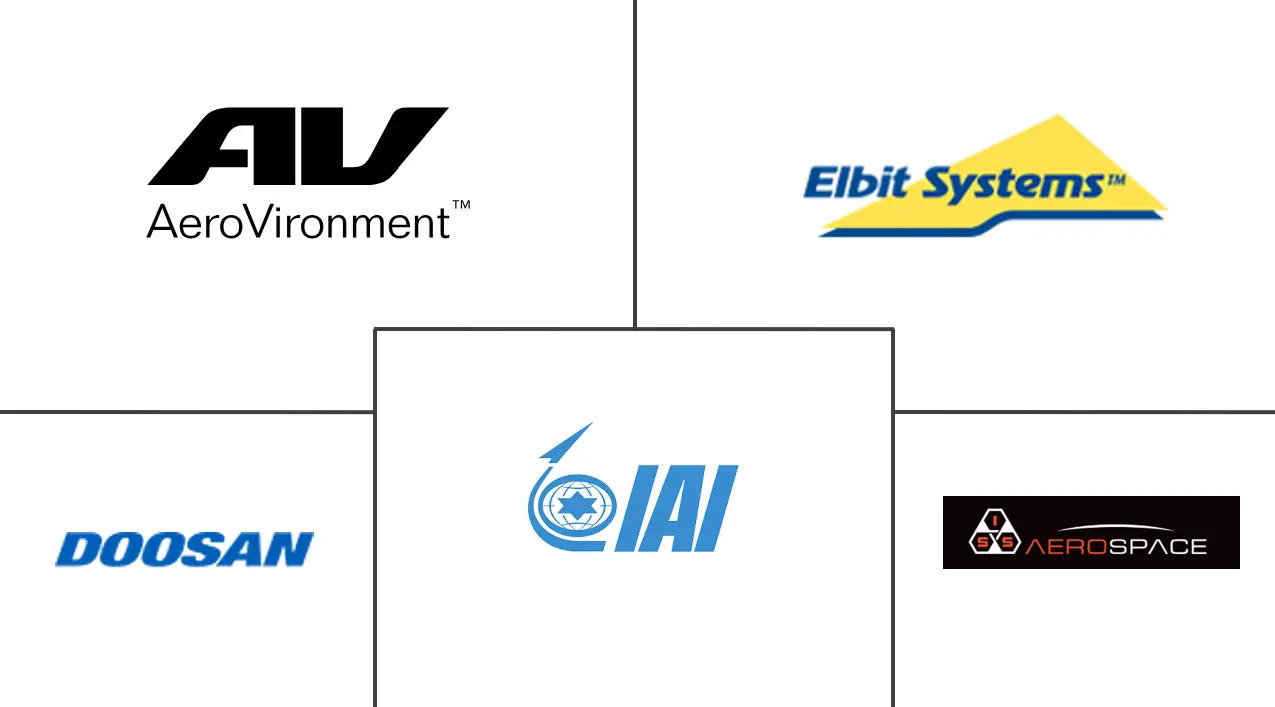Fuel Cell UAV Market Size and Share
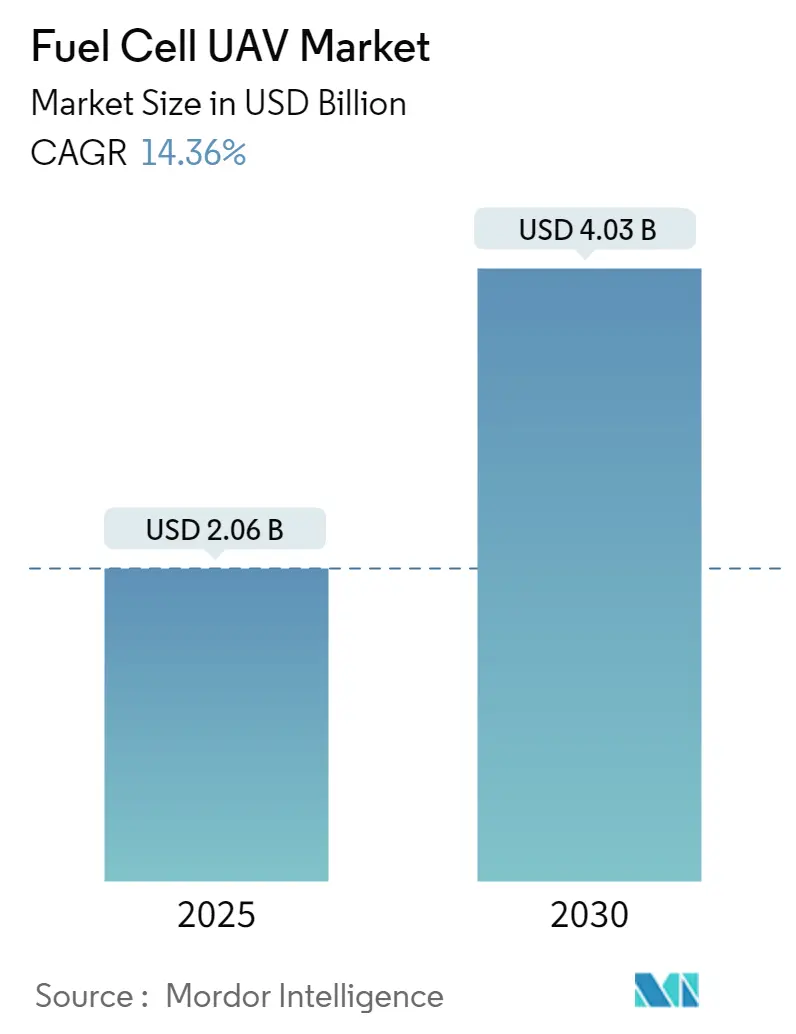
Fuel Cell UAV Market Analysis by Mordor Intelligence
The Fuel Cell UAV Market size is estimated at USD 2.06 billion in 2025, and is expected to reach USD 4.03 billion by 2030, at a CAGR of 14.36% during the forecast period (2025-2030).
The fuel cell UAV market is a transformational segment in the UAV industry, driven by the necessity of extended flight times and reduced environmental impacts. Fuel cell technology offers a compelling alternative to traditional lithium-ion battery technology with its higher energy density and longer endurance. This development addresses the most critical limitations of battery-powered UAVs, which attract fuel cell UAVs to applications with long-duration flights, like surveillance, mapping, and inspection conducted in remote areas.
Key players in the unmanned aerial vehicle (UAV) industry are now developing and integrating the fuel cell system into their UAV platform. This has led to a diversified range of products catering to various industrial needs. The potential of hydrogen fuel cells to deliver continuous and reliable power over prolonged periods is a significant reason behind their adoption, both for commercial and military applications.
The regulatory bodies, including the Federal Aviation Administration (FAA) and the European Union Aviation Safety Agency (EASA), have begun to acknowledge the benefits of fuel cell technology; they have exempted and approved its wide use. These regulation changes have opened new perspectives and areas for adopting fuel cell UAVs in agriculture, infrastructure monitoring, logistics, and military and emergency response. This represents an increase in operational efficiency and a lower carbon footprint, aligning them with global sustainability goals.
Despite the promising outlook, challenges with respect to the fuel cell UAV market include high costs for development, a limited hydrogen refueling infrastructure, and stringent safety regulations. Complex integration of fuel cell systems into the UAVs, in turn, requires strong R&D efforts and expertise. However, continuous development in hydrogen production and storage technologies, with the help of supportive government policies, is expected to overcome such challenges. Therefore, the fuel cell UAV market will experience tremendous growth with continuous technological developments and increasing emphasis on sustainable aviation solutions.
Global Fuel Cell UAV Market Trends and Insights
The Military Segment to Dominate Market Share During the Forecast Period
The military segment is expected to show significant growth during the forecast period. The main factors attributable to such growth include an increase in the budget of various defense forces worldwide and the increased need for advanced fuel cell UAV systems by various military personnel to carry out critical battlefield missions. These factors are expected to contribute to market growth in the future.
The military sector highly demands advanced UAV technologies to enhance surveillance, reconnaissance, and combat capabilities. Fuel Cell UAVs offer extended flight endurance, stealthy operations, and reduced logistical burden, making them well-suited for military applications. Additionally, the military sector has the necessary resources and budget to invest in cutting-edge technologies, leading to the segment gaining a critical advantage in the market.
Fuel cells can be used to power soldiers' gear or fly unmanned aircraft, and they are currently becoming an attractive option for defense personnel worldwide. Fuel cells can increase the airtime of drones by hours and charge in just minutes. Unmanned aerial vehicles (UAVs) are typically used for military operations where manned flights would be too risky or difficult. Moreover, the growing complexity of battlefield scenarios has led to an increase in the usage of UAVs by defense personnel of various countries worldwide to carry out critical mission functions.
The strategic contracts and technological advancements underscore the military's growing reliance on fuel cell UAVs to enhance operational capabilities. The extended flight times reduced logistical burdens, and improved stealth features of fuel cell-powered UAVs make them a valuable asset for military applications, driving their dominant market share in the sector. These developments reflect the ongoing commitment of military forces to integrate advanced fuel cell technologies into their UAV fleets to meet evolving operational requirements.
In December 2023, Haberbusch's NEOEx Systems Inc. won a USD 6.4 million subcontract to develop the US Army's drone refueling and flight systems. NEOEx is developing a portable refueling station that can provide liquid hydrogen to drones weighing up to 55 pounds. UAVs fitted with NEOEx's onboard storage and power systems can fly for as long as 20 hours and cover distances up to 1,000 miles.
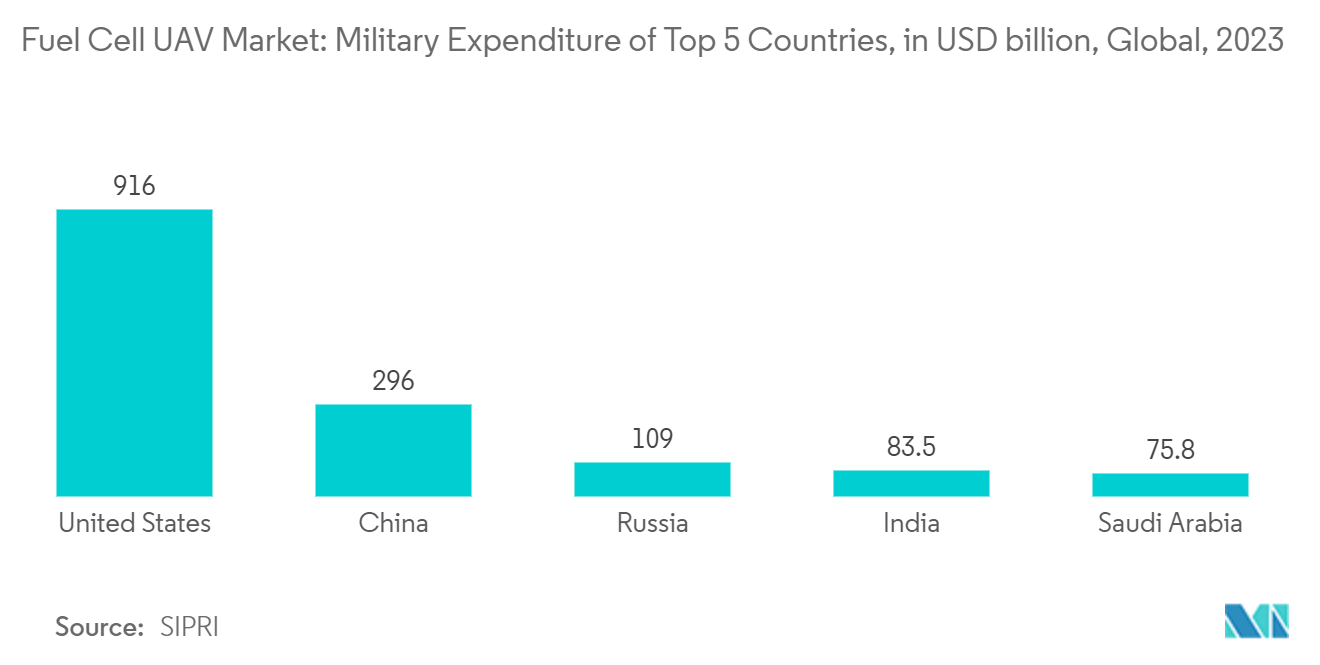
Asia-Pacific to Witness Highest Growth During the Forecast Period
The Asia-Pacific fuel cell UAV market is expected to show the highest growth rate during the forecast period. Rising demand for UAVs across sectors like agriculture, surveillance, and logistics will greatly contribute to the adoption of fuel cell technology. Additionally, government initiatives are enhancing UAV capabilities for defense and commercial applications.
Major contracts and strategic collaborations are driving this market. For example, in April 2023, Doosan Mobility Innovation partnered with DroneUp LLC to test and optimize advanced hydrogen fuel cell technology for drone operations. Such partnerships aim to enhance the efficiency and performance of fuel cell UAVs, thereby enhancing their adoption.
At the same time, various fuel cell manufacturers are signing contracts with government and private entities to deploy fuel cell UAVs for various applications. Companies are establishing new production facilities and extending their presence in emerging markets of Asia-Pacific. For example, major fuel cell UAV manufacturers are operating in countries such as China, Japan, and South Korea to address the increasing demand.
Research and development activities are crucial for the advancement of fuel cell technology in UAVs. Leading companies are investing heavily in R&D to improve fuel cell efficiency, power density, and integration with UAV systems. Hydrogen storage and fuel cell design innovations result in lighter, more efficient, and longer-endurance UAVs. Also, collaborations with research institutions and universities foster technological advancements and accelerate the development of next-generation fuel cell UAVs.
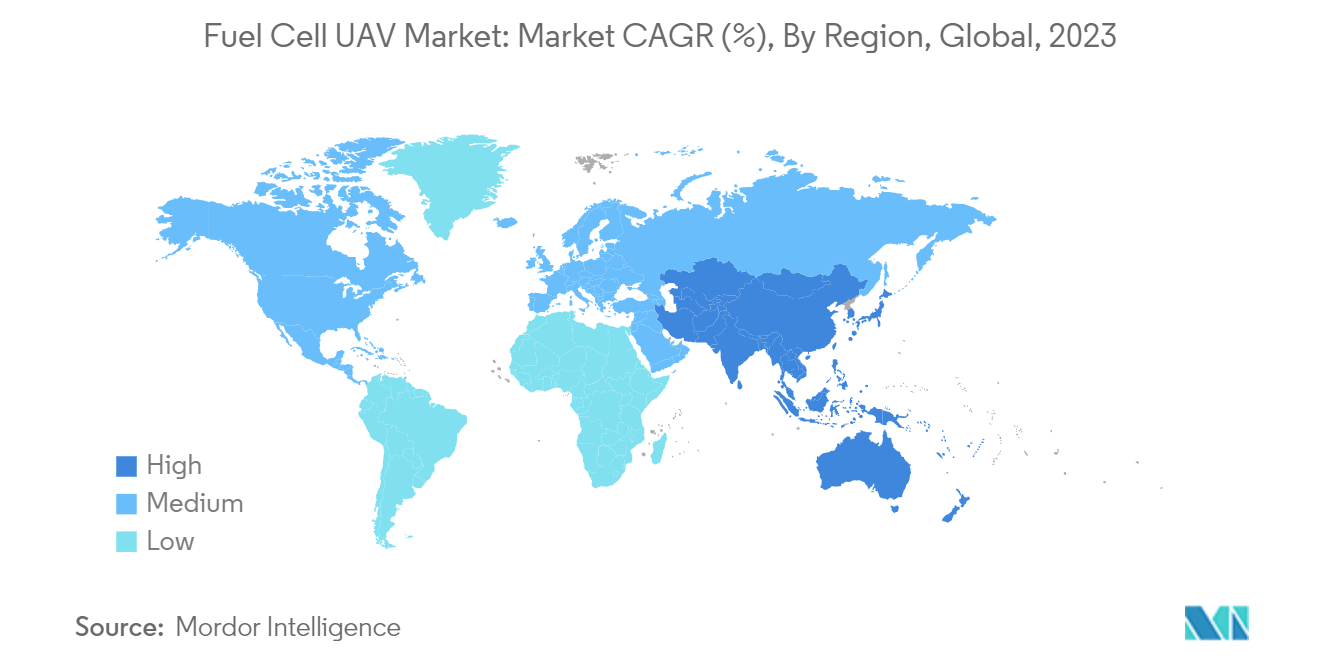
Competitive Landscape
The fuel cell UAV market is semi-consolidated. Some prominent market players are AeroVironment Inc., Elbit Systems Ltd, Israel Aerospace Industries Ltd, ISS Group Ltd, and Doosan Corporation. These key players focus on developing advanced fuel cell UAV systems that both commercial and military operations will use.
The companies invest in R&D to improve fuel cell efficiency, power density, and UAV platform integration. Companies are focusing on reducing production costs through advanced manufacturing techniques and optimization of supply chains. In this instance, much concern is focused on regulatory compliance, certifications, sustainability, and strong marketing and branding. They strongly focus on technological innovation, strategic cooperation, market access, and cost efficiency, which are crucial in delivering high-performance and ecologically safe fuel cell UAV solutions for diversified applications. For instance, in April 2023, Doosan Mobility Innovation partnered with DroneUp LLC to optimize hydrogen fuel cells for drone operations, enhancing Doosan's strategic position in the fuel cell UAV market.
Fuel Cell UAV Industry Leaders
-
Elbit Systems Ltd.
-
Israel Aerospace Industries Ltd.
-
Doosan Corporation
-
AeroVironment, Inc.
-
ISS Group Ltd.
- *Disclaimer: Major Players sorted in no particular order
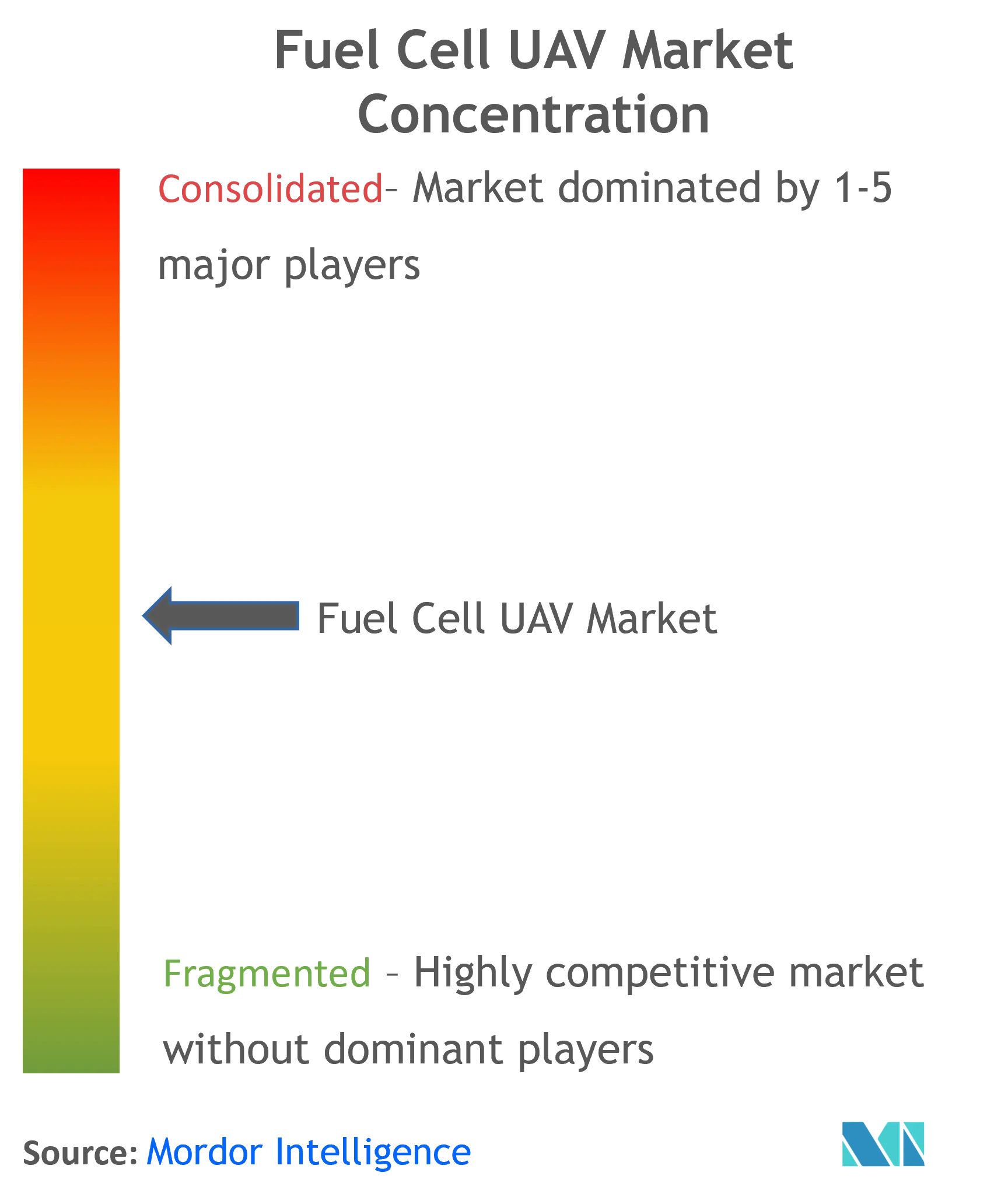
Recent Industry Developments
September 2023: Honeywell International Inc. announced a year-long collaboration with the US Department of Energy’s National Renewable Energy Laboratory to develop and commercialize the cartridge-based hydrogen fuel storage solution for Uncrewed Aerial Vehicles. The initiative is a strategic approach to applying the hydrogen technologies supported by the DOE to practical and real-world use in propulsion for UAVs.
April 2023: DroneUp LLC, an autonomous drone delivery and services provider, collaborated with Doosan Mobility Innovation (DMI) to test DMI's advanced hydrogen fuel cell technology. This collaboration aims to optimize hydrogen fuel cells for drone operations. Doosan Mobility Innovation (DMI) is a leader in hydrogen fuel systems for small uncrewed aerial systems (sUAS). Its fuel cells provide a 3:1 energy density advantage over lithium batteries and extend drone flight times to 2-5 hours, depending on payload and weather.
Global Fuel Cell UAV Market Report Scope
A fuel-cell propulsion system powers a fuel-cell unmanned aerial vehicle (UAV). A fuel cell is an electrochemical device that generates electricity by combining hydrogen (usually stored in a tank) with oxygen from the air, producing water and releasing energy. This energy is then used to power the UAV's motors and other systems.
The fuel cell UAV market is segmented based on end user and geography. By end user, the market is segmented into commercial and military. The report also covers the market sizes and forecasts for the fuel cell UAV market in major countries across different regions. For each segment, the market size is provided in terms of value (USD).
| Commercial |
| Military |
| North America | United States |
| Canada | |
| Europe | United Kingdom |
| France | |
| Germany | |
| Rest of Europe | |
| Asia-Pacific | China |
| Japan | |
| India | |
| South Korea | |
| Rest of Asia-Pacific | |
| Latin America | Brazil |
| Mexico | |
| Rest of Latin America | |
| Middle East and Africa | United Arab Emirates |
| Saudi Arabia | |
| Qatar | |
| Rest of Middle East and Africa |
| End User | Commercial | |
| Military | ||
| Geography | North America | United States |
| Canada | ||
| Europe | United Kingdom | |
| France | ||
| Germany | ||
| Rest of Europe | ||
| Asia-Pacific | China | |
| Japan | ||
| India | ||
| South Korea | ||
| Rest of Asia-Pacific | ||
| Latin America | Brazil | |
| Mexico | ||
| Rest of Latin America | ||
| Middle East and Africa | United Arab Emirates | |
| Saudi Arabia | ||
| Qatar | ||
| Rest of Middle East and Africa | ||
Key Questions Answered in the Report
How big is the Fuel Cell UAV Market?
The Fuel Cell UAV Market size is expected to reach USD 2.06 billion in 2025 and grow at a CAGR of 14.36% to reach USD 4.03 billion by 2030.
What is the current Fuel Cell UAV Market size?
In 2025, the Fuel Cell UAV Market size is expected to reach USD 2.06 billion.
Who are the key players in Fuel Cell UAV Market?
Elbit Systems Ltd., Israel Aerospace Industries Ltd., Doosan Corporation, AeroVironment, Inc. and ISS Group Ltd. are the major companies operating in the Fuel Cell UAV Market.
Which is the fastest growing region in Fuel Cell UAV Market?
Asia Pacific is estimated to grow at the highest CAGR over the forecast period (2025-2030).
Which region has the biggest share in Fuel Cell UAV Market?
In 2025, the North America accounts for the largest market share in Fuel Cell UAV Market.
What years does this Fuel Cell UAV Market cover, and what was the market size in 2024?
In 2024, the Fuel Cell UAV Market size was estimated at USD 1.76 billion. The report covers the Fuel Cell UAV Market historical market size for years: 2019, 2020, 2021, 2022, 2023 and 2024. The report also forecasts the Fuel Cell UAV Market size for years: 2025, 2026, 2027, 2028, 2029 and 2030.
Page last updated on:
Fuel Cell UAV Market Report
Statistics for the 2025 Fuel Cell UAV market share, size and revenue growth rate, created by Mordor Intelligence™ Industry Reports. Fuel Cell UAV analysis includes a market forecast outlook for 2025 to 2030 and historical overview. Get a sample of this industry analysis as a free report PDF download.
